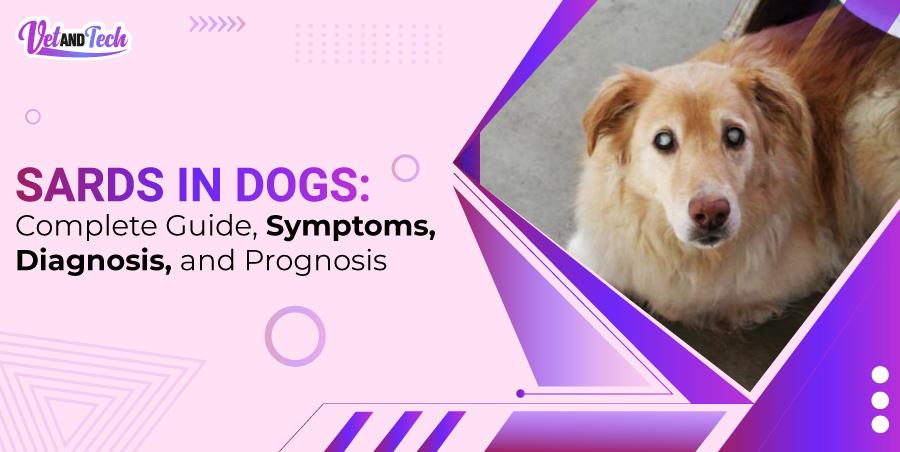SARDS In Dogs: Complete Guide, Symptoms, Diagnosis, and Prognosis
Sudden Acquired Retinal Degeneration Syndrome (SARDS) is a condition that affects dogs and leads to sudden vision loss. Sards in dogs are one of the most common causes of vision loss in your furry pets, especially in dog females. Moreover, this condition occurs in dogs more often in middle age, spayed dogs, and older females.
Additionally, blindness in dogs can be caused by numerous factors, such as hereditary or retinal problems. Sometimes, they are born without vision or may lose sight gradually, but that’s not the case with every dog. This condition can happen suddenly in dogs due to abnormal functioning of the retina tissues.
If you are a pet parent, never skip reading it to learn about the disease, what is sards in dogs, their causes, symptoms, diagnosis, and best preventive measures.
What is SARDS in Dogs?
SARDS is common in pet dog breeds that usually affect the functions and activities of retinal tissues, primarily directed toward irreversible blindness. This disease produces over days to weeks, and in some cases, it comes nearly overnight, and ultimately, animals come to that point where they can’t compensate for their losing vision continuously.
Sards in dogs symptoms are usually shown in adults and female dogs, generally around 6 to 14 years of age. However, larger breeds are primarily at risk of having Sards, especially Schnauzers, dachshunds, and other purebreds are more inclined towards this condition.
Which Dog Breeds Can Get SARDS?
Unfortunately, all kinds of dog breeds can get sards, and it is more common in crossbreeds since this disease affects the eyes with sudden vision loss, which gradually increases over days to weeks.
Here are some particular breeds which have more risk factors while having sards;
- Beagles
- Brittany Spaniels
- Bichons
- Maltese
- Cocker Spaniels
- Pugs
- Springer Spaniels
- Miniature Schnauzers
- Dachshunds
Can a Dog with SARDS Live?
Watching your companion with sudden vision loss due to SARDS can be heartbreaking. Initially, it's difficult for your furry pet to learn, understand, and navigate the world without vision.
However, different practices and resources, such as gentle touching to feel the sense of where they are in the home, can provide a secure and stimulating environment. In this way, they can learn to cope, and it’s viable to living a dog with sards. Eventually, your attention and regular exercise can make it possible for them to live a quality life.
Signs & Symptoms of Vision Problems in Dogs
Although sudden vision loss is the most apparent sign of sards in dogs symptoms, regardless of the reasons, there are various indicators that you should know and be aware of if you are a concerned pet owner of a dog. There are the following sards dog symptoms if your furry pup is experiencing difficulty in seeing or even facing complete blindness.
- Easily startled, dazed, and confused
- Eyes become cloudy and bumping
- Behavioral changes, anxiety, and hesitation
- Unwillingness to go and move up and down stairs
- Puffy, Swollen, or Inflamed eyes
- Pawing at the face and irritation in the eyes
- Mild eye redness and irregular blinking
- Dilated pupils and no response to light
- Increase appetite, thirst, and urination
- Sudden weight increase
These key signs and symptoms mainly cause SARDS, especially in spayed and adult dogs. If you are a pet owner or love your furry friend, you must consider your dog's physical and behavioral changes.
If your dog is indicating any of these symptoms of blindness, plan an appointment to see your veterinarian for an early diagnosis and start treatment immediately.
Main Causes That Lead to SARDS in Your Furry Pet
Much like humans, your furry pet's vision can become impaired due to having SARDS, injury, aging, and hereditary conditions. That’s entirely true while understanding that sudden vision loss is often not a primary health problem. But the above-mentioned symptoms can cause different physical disorders such as; Kidney issues, affect liver functioning, and lead to heart diseases.
Some Most Common Causes of Blindness in Dogs Include;
Diabetes:
Diabetes issues are most commonly increasing in dogs which may increase the risk the factor of vision loss due to poor nutrition in the diet. This ultimately causes weight gain, which can result in complete or partial blindness in dogs.
Cataracts:
The eye lens becomes opaque and thick when a dog progresses the contracts. Building a gray/whitish area in the center part of the eye gradually stops the lightning effect from reaching the retina. When it shows in your dogs, early diagnosis is essential to prevent complete blindness. This can help the dogs to save their vision through surgical procedures. Moreover, contract development is estimated for up to 75%in dogs with diabetes.
Glaucoma:
Glaucoma is a painful situation for dogs that can be curable if it is detected earlier. Spotting this issue and diagnosing earlier is suitable for the best treatment outcomes. If your dog is showing green/yellow discharge from their eyelids, bloodshot eyes, dilated pupils, and get slow to react to bright light, then you must consult with your expert veterinarian to help and save your do’s vision.
Progressive Retinal Atrophy:
This painless condition, progressive retinal atrophy (PRA), leads the retina damage, which causes instant vision loss in both eyes. It may be inherited or grows slower, allowing your beloved pet to adjust to losing sight frequently. Unfortunately, there’s no any treatment for this disease if you don’t do the early detection.
Retinal Detachment:
This condition refers to retina detachment from the back of the dog’s eye. which can cause the complete or partial blindness. The crucial signs and causes depend upon the extension of the retina, while there are numerous causes of retina detachment which ultimately causes the sards in female and adult dogs. It may be caused due to several reasons, such as;
- Systemic Hypertension/ High Blood pressure
- Bacterial, Fungal, and viral infections in dogs
- Immune-mediated Diseases in Dogs
Diagnosis of SARDS In Dogs
During the examination, your veterinary ophthalmologist checks the pupil response to light and finds structural abnormalities in retinal tissues. Moreover, confirmation of retinal dysfunction requires electrodiagnostic eye testing. This diagnostic test is known as an Electoretinodiagram (ERG), which ultimately measures the retina's electrical activity and ensures the diagnosis of SARDS.
Sometimes, it helps to lead the potential therapy to diagnose more severe and treatable Central nervous system CNS conditions. The result eventually shows no retina electrical activity, and your vet confirms 100% having SARDS in dogs.
Treatment & Best Tips and Tricks
Unfortunately, SARDS in dog treatment is sometimes incurable, so most dogs remain irreversibly blind. As a pet parent, you are trying hard to find and to do anything to help your furry friends. You will be pleased to hear the good news, this condition is not so painful, and your buddies can go on to stay happy with long lives.
Furthermore, if your dog is suffering from acute blindness, it can be adjusted. Luckily, vision is not a dog’s most dominant sense, and without sight, your buddy will rely more heavily on the other senses, like smell, etc.
Helpful advice from a veterinarian: Try to avoid buying unnecessary things and products for your buddies that are common in the market to cure SARDS. Don’t get them in trouble; ensure to make their lives as comfortable as possible and always be there when they need your attention.
Seven Pro Tips For Carrying Your Blind Dog
Furthermore, there are some pro tips to look after your blind dog effectively, which are appended below;
- Don’t Panic in front of your blind dogs
- Do proper check-ups with your vet
- Keep Your Home Baby Proof
- Keep their training and do practices
- Always Place the things where dogs can find them easily
- Try to use sounds and gentle Touching for sensation
- Update your Dogs ID’s (In case they lose it will help them to reach their own place easily)
How to Help Your Blind Pet Dog?
There are a few easy and important things that every pet owner can do to support the blind dog and accommodate their difference in eyesight:
- Improve environment: Keep avoiding sudden changes in your surrounding environment. Once your dog used to live and adjusted to the living environment, it could be far better to make drastic changes, especially where your dog lives.
- Increase engagements: Try to give different playing tools in which they do make an effort to navigate them gradually. In this way, the blind dog will gently jump toward the walls and furniture quickly. Ensure your pet dog is safe while supporting them to live and stay active.
- Stay connected: you need to be in touch with your pet daily through tactile and verbal commands. But try to avoid making hand gestures instead of guiding them with your voice or gently touching them. Besides, this sense impacts them to feel things and be aware of where they are at home.
In a Nutshell..!
Watching your dog lose its vision is no doubt heartbreaking. Above are numerous ways your furry pet can live comfortably without vision. Apart from this, if you are a pet owner and you are seeing the symptoms of blindness, immediately contact your vet. The veterinarians will be able to detect the main issues of blindness and start treatment if possible. As you find earlier, your dog’s blindness, the quicker you can find ways to cope with it.
At Vetandtech, you can explore and find immense information about pet and vet diseases, their diagnosis, and treatments. Moreover, through this platform, you can get veterinary learning opportunities Such as Continuing Educational Webinars, CE courses, conferences, and vet events. Eventually, you can stay up-to-date on new ideas and trends for veterinary medicine and clinical staff.
In addition, every organization and professional should seek ways to find continuous improvement and learning, whether expanding their technical skills—for example, computer skills, building leadership qualities, multicultural engagement, etc.
If you want to continue learning and improving yourself, You should stay relevant and get in touch with Vet and Tech.
Frequently Asked Questions (FAQs)
What are the difficulties in SARDS in Pet Dogs?
SARDS is usually detected through the ophthalmologic exam. A veterinarian will perform various tests to assess the dog’s visual reflexes and vision. In this case, the pupil will not respond to light.
Is SARDS genetic in Dogs?
Sudden acquired degeneration syndrome (SARDS) is a common cause of leading acute blindness in your furry pets. In rare cases, it can also cause due to the genetic abnormality component in certain breeds, such as Dachshunds and Bichons.
Can a dog survive being blind with having SARDS?
Yes, your furry friends can definitely survive being blind. In fact, most dogs can live happily or stay normal in their lives. They will just need particular adjustments to cope with this disease, such as training, verbal commands, and gentle touching.








